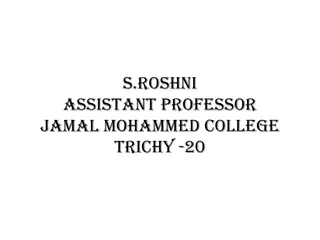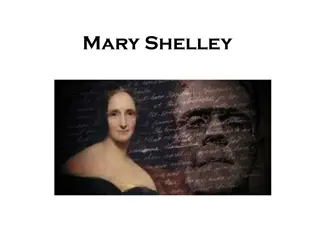Exploring Percy Bysshe Shelley's "Ozymandias" in AQA Power and Conflict Poetry
Delve into the world of Percy Bysshe Shelley's "Ozymandias" as part of the AQA Power and Conflict Poetry module. Uncover the themes of power and conflict, understand the historical context, and analyze the symbolism of statues in the poem. Engage with oracy tasks, context summaries, and poem analysis while unraveling the story of Ozymandias, the Egyptian Pharaoh Rameses II. Discover how Shelley's Romanticism influences his work and ponder over the transient nature of power and monuments through this thought-provoking exploration.
Download Presentation

Please find below an Image/Link to download the presentation.
The content on the website is provided AS IS for your information and personal use only. It may not be sold, licensed, or shared on other websites without obtaining consent from the author. Download presentation by click this link. If you encounter any issues during the download, it is possible that the publisher has removed the file from their server.
E N D
Presentation Transcript
AQA POWER AND CONFLICT POETRY OZYMANDIAS BY PERCY BYSSHE SHELLEY
What is happening in this picture? What do you think this event could symbolise? What are the connotations of a statue? YOUR STARTER: ORACY TASK
ORACY TASK: CONSIDER THIS These are places that once represented power. What are they like now? What do you think this poem will be about?
CONTEXT: SUM UP THE INFORMATION IN 5 BULLET POINTS Percy Bysshe Shelley was a ROMANTIC poet. Many ROMANTIC poets wrote about the power of nature and time, exotic lands and criticised the ruling classes. All of these themes link to Ozymandias . Ozymandias is Shelley s most famous sonnet, and one of the best known in English Literature, although it does not stick strictly to the rules of the usual sonnet form. Shelley was against many of the conventions of his time. The poem was written in 1817. The historical context is the archaeological finds that had been made in Egypt, which were Shelley s inspiration. Ozymandias was another name for the Egyptian Pharaoh Rameses II. TODAY S KEY QUESTIONS: How does the poem, Ozymandias , link to the themes of POWER and CONFLICT? 2. What is Romanticism and how has it influenced Percy Bysshe Shelley s Ozymandias ? 3. What should I be looking for when analysing a poem? 1.
YOUR TASK: POEM RUN In front of me, I have a copy of Ozymandias . You will have FOUR chances in your group to come up and look at the poem. Take in as much information as you can before going back to your table and writing down any points you can remember. BEWARE! The point of this task is not to memorise the poem. Instead, you need to be looking at groups of words that are used, the structure of the poem or the length of the lines. What do you initially notice?
WHAT IS THE POEM ABOUT? This poem is based on a story Shelley had read about a funeral temple of the Egyptian pharaoh, Rameses II, whom the Greeks called Ozymandias . According to the story, the temple bore an inscription which read: I am Ozymandias, king of kings; if anyone wishes to know how great I am and the place where kings like me lie, let him surpass any of my works.
WHAT IS THE POEM ABOUT? However, he used slave labour to build them and the slaves suffered hardship under his control. Today, many of these memorials and statues have crumbled into the sands of the desert. Rameses II during his reign built more temples and monuments, took more wives (8) and had more children (over 100) than any other pharaoh. He wanted to built memorials for himself, which he imagined would last forever.
WHAT IS THE MEANING OF SHELLEYS TITLE? O zymandias Ozy comes from the Greek ozium which means either, to breathe or air . Mandias comes from the Greek mandate which means to rule . How does this reflect what we know about the poem already? TODAY S KEY QUESTIONS: How does the poem, Ozymandias , link to the themes of POWER and CONFLICT? 2. What is Romanticism and how has it influenced Percy Bysshe Shelley s Ozymandias ? 3. What should I be looking for when analysing a poem? 1.
OZYMANDIAS I met a traveller from an antique land Who said: Two vast and trunkless legs of stone Stand in the desert. Near them, on the sand, Half sunk, a shattered visage lies, whose frown, And wrinkled lip, and sneer of cold command, Tell that its sculptor well those passions read Which yet survive, stamped on these lifeless things, The hand that mocked them and the heart that fed: And on the pedestal these words appear: 'My name is Ozymandias, king of kings: Look on my works, ye Mighty, and despair!' Nothing beside remains. Round the decay Of that colossal wreck, boundless and bare The lone and level sands stretch far away. TODAY S KEY QUESTIONS: How does the poem, Ozymandias , link to the themes of POWER and CONFLICT? 2. What is Romanticism and how has it influenced Percy Bysshe Shelley s Ozymandias ? 3. What should I be looking for when analysing a poem? 1.
ANALYSING THE POEM On your table you have a set of questions that will help you analyse Ozymandias . You can answer these as a group, in pairs or by yourself. Answer as annotations in your anthology. Be as detailed as possible. Questions in bold are challenging. Once we have completed this activity we will share our ideas as a class to make sure we understand what is happening in Shelley s poem. TODAY S KEY QUESTIONS: How does the poem, Ozymandias , link to the themes of POWER and CONFLICT? 2. What is Romanticism and how has it influenced Percy Bysshe Shelley s Ozymandias ? 3. What should I be looking for when analysing a poem? 1.
ORACY TASK You have TWO minutes to discuss the questions on your table. You must NOT write anything in this two minutes. It is purely for discussion. When your time is up, I will give you one minute to add any notes to your copy of the poem. Make sure you have something ready to contribute.
CLASS FEEDBACK I met a traveller from an antique land Who said: Two vast and trunkless legs of stone Stand in the desert. Near them, on the sand, Half sunk, a shattered visage lies, whose frown, And wrinkled lip, and sneer of cold command, Tell that its sculptor well those passions read Which yet survive, stamped on these lifeless things, The hand that mocked them and the heart that fed: And on the pedestal these words appear: 'My name is Ozymandias, king of kings: Look on my works, ye Mighty, and despair!' Nothing beside remains. Round the decay Of that colossal wreck, boundless and bare The lone and level sands stretch far away. TODAY S KEY QUESTIONS: How does the poem, Ozymandias , link to the themes of POWER and CONFLICT? 2. What is Romanticism and how has it influenced Percy Bysshe Shelley s Ozymandias ? 3. What should I be looking for when analysing a poem? 1.
YOUR OPINION Shelley wrote Ozymandias in friendly competition with his friend and fellow poet Horace Smith (1779 1849), who also wrote a sonnet on the same topic with the same title. Smith's poem was published in The Examiner a few weeks after Shelley's sonnet. Both poems explore the fate of history and the ravages of time: even the greatest men and the empires they forge are impermanent, their legacies fated to decay into oblivion. Which one do you prefer? IN Egypt's sandy silence, all alone, Stands a gigantic Leg, which far off throws The only shadow that the Desart knows: "I am great OZYMANDIAS," saith the stone, "The King of Kings; this mighty City shows "The wonders of my hand." The City's gone, Nought but the Leg remaining to disclose The site of this forgotten Babylon. I met a traveller from an antique land Who said: Two vast and trunkless legs of stone Stand in the desert. Near them, on the sand, Half sunk, a shattered visage lies, whose frown, And wrinkled lip, and sneer of cold command, Tell that its sculptor well those passions read Which yet survive, stamped on these lifeless things, The hand that mocked them and the heart that fed: And on the pedestal these words appear: 'My name is Ozymandias, king of kings: Look on my works, ye Mighty, and despair!' Nothing beside remains. Round the decay Of that colossal wreck, boundless and bare The lone and level sands stretch far away. VS We wonder, and some Hunter may express Wonder like ours, when thro' the wilderness Where London stood, holding the Wolf in chace, He meets some fragment huge, and stops to guess What powerful but unrecorded race Once dwelt in that annihilated place.
Lets revisit this picture. Can you add anything else to your initial impressions? What is this picture saying about power? TO CONCLUDE: ORACY TASK
ORACY TASK #1 Whose work has lasted through the statue? Ozymandias or the sculptor s? What message is Shelley trying to present to his reader?
ORACY TASK #2 Nothing beside remains. What is the effect of this line? What could it mean? Could it have TWO meanings? Consider what has happened to Ozymandias power.
ORACY TASK #3 Does the poem remind you of any modern figures? If so, who? Why?
ORACY TASK #4 Where is the POWER and CONFLICT in this poem? Discuss specific examples. Is Shelley saying anything about the power of nature in this poem? If so, what?
ORACY TASK #5 My name is Ozymandias, king of kings Look on my works, ye Mighty, and despair! What feelings do you think these lines were meant to evoke at the time the statue was built? What feelings do they now evoke from a modern perspective?























